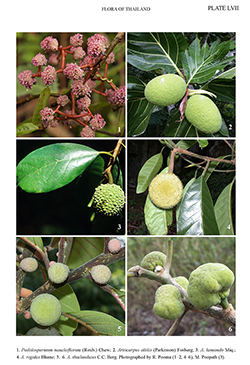e-Flora of Thailand
Volume 10 > Part 4 > Year 2011 > Page 481 > Moraceae > Artocarpus
1. Artocarpus altilis (Parkinson) Fosbergwfo-0000550425
J. Wash. Acad. Sci. 31: 95. 1941; Fosberg, Brittonia 12: 104. 1960; C.C.Berg et al., Fl. Males., Ser. 1, Spermat. 17(1): 82. 2006.— Sitodium altile Parkinson, J. Voy. Endeavour: 45. 1773. Plate LVII: 2.
Accepted Name : This is currently accepted.
Synonyms & Citations :
Description : Tree to 25(–40) m tall, evergreen. Leafy twigs 10–20 mm thick, minutely white appressed puberulous to hispidulous, scabridulous, drying brown. Leaves spirally arranged; lamina (sub) coriaceous, elliptic to subrhombic to obovate in outline, 20–80(–100) by 15–50(–60) cm, mostly pinnatifid with 1–5(–9) pairs of lateral lobes, base cuneate to subcordate, apex acuminate to acute, margin subentire, ± revolute to flat; upper surface minutely white (appressed-)puberulous to hispidulous, also sparsely brown subhirtellous on the main veins (or subglabrous), scabridulous to smooth, lower surface minutely white appressed-puberulous, scabridulous to smooth; lateral veins 9–13 pairs, tertiary venation scalariform, ± prominent; petiole 3–9 cm long, 3–7 mm thick, minutely white appressed-puberulous to hispidulous, scabridulous; stipules (3–)10–25 cm long, white appressed-puberulous, also brown subhirsute to pubescent, mainly on the midrib, the margins and towards the apex, caducous. Staminate inflorescences axillary, solitary; peduncle 1–6 cm long, white appressed-puberulous to hispidulous, scabridulous; head cylindrical to clavate to spicate, 5–30(–40) cm by (0.5–)1–3(–5.5) cm; perianth tubular, 1–2 mm long, the apex 2-lobate, subhispidulous or subglabrous; stamen ca 1.5–3 mm long, anther 0.6–0.8 mm long; interfloral bracts absent. Pistillate inflorescences axillary, solitary; peduncle (2–)5–10(–14) cm long, white appressed puberulous to hispidulous, scabridulous; head ellipsoid to subglobose; perianth (in the seedless form) cushion-shaped, ca 1 mm long, whitish to brownish hispidulous to puberulous, the apex apiculate, 2-lobate; stigma simple; interfloral bracts absent. Infructescences ellipsoid to subglobose, ca 15–30 by 10–30 cm diam., (in the seedless form) covered with 1 mm high, cushion-shaped apices of perianths; fruits ellipsoid, ca 2–2.5 cm long.
Thailand : Cultivated in gardens, throughout the country.
Distribution : Indigenous in eastern Malesia (the Philippines, Moluccas, New Guinea) and in cultivation, initially in the Pacific (type) and subsequently throughout the tropics, with various cultivars, seeded and seedless ones, it is not known whether both the seeded and seedless forms are represented in Thailand.
Vernacular : Sake (สาเก), khanun sampalo (ขนุนสำปะลอ)(Central).
CommonName : Breadfruit, Breadnut for seeded form.
Uses: Fruit eaten locally (preserved in syrup).

